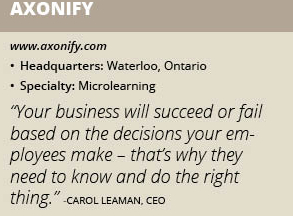
Driving Growth with Operational Excellence
In today’s fierce markets, lean manufacturing and continuous improvement are no longer enough to stay ahead of the competition. To remain relevant, many manufacturers are pursuing operational excellence. And with good reason. Operational excellence moves organizations beyond minimizing waste to consistent and reliable execution that drives both growth and competitive advantage.
But to drive growth and gain competitive advantage, you need to achieve results. And that requires establishing attainable goals against which to measure your success, like improved safety performance, higher product quality and increased value stream productivity.
Safety, quality and productivity all factor heavily into the quest for operational excellence – but you can’t pursue one at the expense of another. Think of these three priorities as legs on the same stool. If one is shorter or longer than the others, the stool is unstable. In other words, improving productivity with an increase-yield-at-all-costs mindset would negatively impact both safety and quality. Similarly, obsessively focusing on quality would slow down productivity. You need to find the balance between these sometimes-competing priorities to keep operations steadily humming along.
The Common Denominator
Regardless of the safety, quality or productivity target you set, there’s a common denominator: your people. In order to achieve any goal, your people need to know and do the right thing at the right time. So, you can set out to lower your total recordable incident rate (TRIR), decrease your customer rejects or reach 85+ percent overall equipment effectiveness (OEE), but if your people don’t have the knowledge and tools they need to execute properly – reliably and consistently, operational excellence will elude you.
Not All Traditions Should be Honored
To equip the frontline with everything they need to do their jobs, manufacturers traditionally pull employees off the floor for hours- or days-long training sessions that overwhelm them with one-size-fits-all content – most of which they quickly forget.
But how does taking employees away from their jobs for long periods of time increase productivity? How does inundating them with more information than they can possibly remember improve safety? And what about one-size-fits-all content? How does that help to ensure quality when everyone has a different role?
It doesn’t. In fact, if you’re relying on traditional training approaches, you’re holding your frontline – and your business – back from achieving results. Old ways just don’t work to create long-term knowledge and lasting behavior change.
Since We’ve Acknowledged the Elephant in the Room…
How do you equip your frontline with the knowledge and tools they need to do the right thing at the right time, every time, so your organization can achieve its goals?
To Achieve Big Results, Start Small
What you’re really asking is the age-old question of how to eat an elephant. (Or, in this particular case, how to help your employees eat an elephant.) And, just like the proverb says, the best way is one bite at a time.
So, if one of your goals is to lower your lost-time injury frequency fate (LTIFR), rather than flooding employees with a barrage of overly general information all at once (like traditional training methods do), a more sensible approach is to deliver bite-sized chunks of customized content to each employee repeatedly, over time. Content that is short and focused can be easily consumed at the beginning of a shift, so employees
aren’t pulled away from their jobs.
When information is customized (to an individual’s skills, experience, knowledge and role) and adaptive, it adjusts to continually support each employee as they progress throughout their career. And when it’s continuously reinforced, you can ingrain knowledge and fundamentally change behaviors. But none of this matters if your employees aren’t engaging with the content, so this process needs to be fun.
Now Think Bigger
This approach to equipping your frontline may sound like something of a pipe dream. After all, it’s tantamount to having an all-knowing coach available on-demand (for the entirety of the shift – and beyond) to provide the updates, alerts and answers each employee needs to do the right thing on the job. Realistically, especially for large organizations, this scenario just isn’t feasible. But what if it was? Think of what you could achieve!
To bring it back to the goal of lowering LTIFR, a coach could not only identify things (like bad form when lifting heavy objects), but reinforce the correct form to prevent potential injury, thereby nipping bad habits in the bud to change behaviors, bringing you ever closer to operational excellence.
What if there was a way to make this dream a reality? And what if you could make it automated and scalable?
There is. Enter microlearning.
An Innovative and Proven Approach to Training
Microlearning is a modern approach to training that delivers content in short, focused bites, fits naturally into the employee’s daily workflow, engages voluntary participation, works with how people actually learn, adapts continuously to ingrain job-specific knowledge, and ultimately drives behaviors that impact specific business results.
 Microlearning combines advanced technologies (like cloud, social, web and mobile) with the fundamentals of brain science to deliver information in the way our brains are proven to learn best. And, using gamification elements, it does so in a way that’s fun. Gamification is a critical element of the microlearning formula and, when done right, it’s one of the major drivers of high engagement.
Microlearning combines advanced technologies (like cloud, social, web and mobile) with the fundamentals of brain science to deliver information in the way our brains are proven to learn best. And, using gamification elements, it does so in a way that’s fun. Gamification is a critical element of the microlearning formula and, when done right, it’s one of the major drivers of high engagement.
Infusing microlearning with gamification and game mechanics accomplishes the impossible: It makes learning irresistible. And it provides the right environment for the brain to ingrain knowledge deep enough to change employee behavior.
Microlearning is more than an industry buzzword or a fleeting fad. It’s an emerging trend that picks up steam with each passing year. In fact, according to the Association for Talent Development, 81 percent of surveyed organizations are currently using (or planning to begin using) microlearning to support their employees.
Microlearning in Action
Despite growing enthusiasm, there are still many questions surrounding this revolutionary approach to training, like: What types of companies and industries are successfully using microlearning? Are there certain applications where microlearning works best? And how are manufacturing organizations in particular using microlearning in the real world?
According to the first-ever “Microlearning Global Benchmark Report,” safety and quality training occurs at a higher rate in manufacturing than in any other industry.
Manufacturing is no stranger to the importance of safety. Employees’ frequent use of dangerous equipment or hazardous materials leads to higher risk of injury or even death, not to mention the big fines and potential criminal penalties associated with violating federal and state safety acts.
Best-in-class manufacturers embed safety and compliance directly into the corporate culture to keep people and property safe. Microlearning provides a better way to mitigate these high safety stakes and helps you achieve your safety goals.
With regards to quality, manufacturers everywhere are dealing with a complex puzzle with pieces that shift depending on the type of product they manufacture or ship. They must meet stringent quality standards for ISO certification and face steep potential fines if they don’t meet government regulations, such as those set out by the Food and Drug Administration. And should a defective product somehow get through their safety nets and into the hands of the end-consumer, it costs the manufacturer big bucks. Manufacturers are turning to microlearning to help tame this quality assurance complexity.
Many leading organizations are leveraging microlearning as a critical component of their operational excellence strategies – whether it’s to reduce safety incidents, increase produce quality or simply bring consistency from team to team and facility to facility.
The Edge You Need
Microlearning is more than just a revolutionary idea for training. When integrated with your business strategy, microlearning delivers the edge you need to compete and win in a hectic, agile and unforgiving industry.
But How Do You Get Started?
1. Establish goals: Start with the results you want to achieve. Whether it’s increasing throughput or decreasing time-to-competency, everything you do (from the technology you implement, the training you deliver, even the people you hire) should support your efforts to achieve these goals.
2. Identify behaviors: Work backwards to identify the behaviors (what people have to do) and foundational knowledge (what people have to know) required to achieve these results. The training you deliver should focus on finding and fixing the wrong behaviors and reinforcing the right ones so that everyone in your workforce is doing the right thing, all the time.
3. Understand workflows: Look at how your people work. Watch how they use their time. Note the tools and resources they use to do their jobs. Look for the right places and times to introduce learning opportunities. This information will be critical as you build your micro-
learning strategy.
4. Partner up: You don’t need to recreate the wheel. Invite trusted partners to help you and your stakeholders determine the best ways to introduce microlearning into your organization. You’ll get started faster and save time, effort and resources along the way.
Your business will succeed or fail based on the decisions your employees make every day. That’s why it’s so important they know and do the right things on the job.
To ensure your employees help (instead of hinder) your operational excellence efforts, your training and frontline behaviors need to align with your strategy. Microlearning enables you to develop the right frontline behaviors so you can reach your business goals.
The reality is, good intentions and a great strategy aren’t enough. Competition is fierce, expectations are high, and so are the stakes. If you want to win, there’s just no way around it: You need your people to know and do the right thing at the right time, every time. Microlearning helps you achieve this objective by getting your employees where they need to be – and keeping them there.
Carol Leaman is an award-winning thought leader and celebrated entrepreneur with an impressive track record of successfully leading tech companies. Prior to Axonify, Leaman was the CEO of PostRank Inc., a social engagement analytics platform she sold to Google. You can read more from her on Training Industry Magazine, ATD, CLO and Fortune. You can reach her at cleaman@axonify.com.